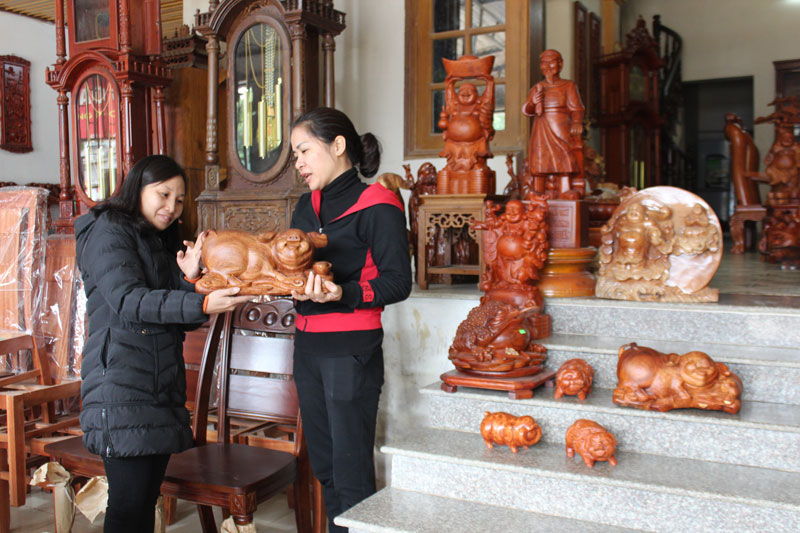
(HBO) – Feng shui pigs in Hoa Binh city are attracting a large number of customers thanks to diverse designs and materials, and reasonable prices.
Many families seek to buy feng shui
pigs to decorate home with a wish for a New Year of peace and prosperity.
High-class
and more meaningful in terms of feng shui are pigs that are made of wood,
resin, gem, natural stone, copper, stone powder, and artificial gem.
Nguyen Thi Huyen, owner of a furniture shop in Phuong Lam ward, Hoa Binh city,
said this year, feng shui wood pigs were particularly favoured by customers.
"Within one month before Tet, I sold nearly 50 feng shui wood pigs,” she said,
adding that most people choose the size of 38cm (length), 15cm (depth), and
20cm (height) because they are "prosperous and lucky” numbers.
It is possible to display feng shui pigs according to the themes "Phat – Tai”
(prosperity) or "Mau tu” (mother and child) or "Heo vang” (golden pig).
Each feng shui pig is sold for between 700,000 VND and 3.5 million VND. The
products are made from Dong Ky wood trade village in Bac Ninh province,
ensuring quality, sophistication, and eye-catching design.
Apart from decorating home, feng shui pigs could be used as a meaningful Tet
gift.
Nguyen Van Hung from Phuong Lam ward, Hoa Binh city said the pigs are round and
well-shaped, symbolising the well-being and abundant fortune. The placing of a
feng shui pig at home is believed to bring prosperity and happiness to families,
he said.
In the five basic elements, pig belongs to the female nature, which is suitable
to present as a gift on the occasion of housewarming, shop launching, business
opening, or longevity celebration events.
"Therefore, on the traditional Lunar New Year, I’ve bought some feng shui pigs
made of stone powder and artificial gem to present my friends and business
partners with a hope that they will have a care-free life,” Hung said./.
The People’s Committee of Lac Son district held a ceremony on April 28 to receive the provincial relic certificate for the ancient rock carving site at Suoi Co stream, located in My Thanh commune.
A special music show titled "The country is in the fullness of joy” has been held at Hoa Binh Square in Hoa Binh city in celebration of the 50th anniversary of the liberation of the South and national reunification (April 30, 1975–2025).
The People's Committee of Lo Son commune, Tan Lac district, has organised the local annual traditional stream fishing festival on April 19 - 20.
As a land deeply intertwined with human history and Vietnam’s millennia-long journey of nation-building and defence, Hoa Binh is often revered for its epic tales and legends.
Residents of Hoa Binh boast a rich cultural identity, reflected in their unique language, traditional attire, customs, and folk melodies – described as "sweet as honey, clear as a mountain stream.”
Lac Son district’s Vu ban town held the 2025 Truong Kha temple festival on April 12–13 (the 15th–16th days of the third lunar month). Since its revival in 2019, the festival has been organised every three years, preserving valuable intangible heritage while meeting the community’s cultural and spiritual needs.



